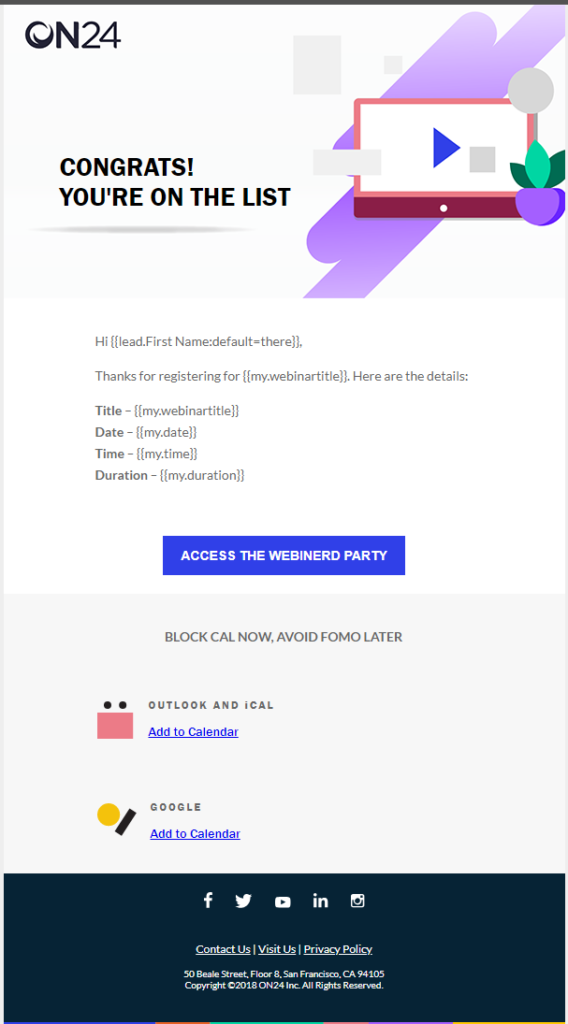This post is the latest in our series on B2B marketing optimization and how to take your marketing efforts to the next level.
Earlier on the ON24 blog, we covered how to optimize your landing pages to turn more of your unknown visitors into known prospects.
As a tactic that is widely preferred by buyers, chances are that you have been using your landing pages to get people to register for webinars. However, if you want to engage those prospects and turn them into leads, ultimately you’ll need them to attend the webinar or watch it on-demand.
You can optimize to drive both attendance and viewings as you host a webinar. Below we’ll explore some of the metrics you can use for setting optimization goals along with some key tactics to help reach them.
What key metrics should I look at for optimizing webinar attendance?
When optimizing for attendance and setting goals, there are numerous metrics to choose from. Just remember to take into account your performance across a series of webinars rather than the performance of a single session. This will keep your eyes on long-term performance and improvement.
Here are a few key metrics to consider when optimizing for attendance of a lead generation webinar:
Attendance percentage rate
There are plenty of benchmarks in ON24’s Webinar Benchmarks Report, and on average 56% of registrants to all webinars with more than 100 attendees end up tuning in.
But this percentage figure varies across function and industry. For example, marketers saw a 39% registration-to-attendance conversion rate.
Look at your own percentage attendance rate and use that as the start of your optimization efforts.
Number of attendees
As well as the percentage attendance rate, look at the total number of attendees you drive through your webinar program.
You might want to consider promoting more webinars (even if the percentage attendance rate may drop) to lift the number of attendees going through your program to your desired level.
Number of qualified attendees
You are likely intent on using webinars to generate leads. So, remember to check the number of qualified registrants who actually view your webinar.
How you define ‘qualified’ in this context will be up to you, but you may account for:
- The number of attendees from organizations with a particular employee headcount.
- The number of attendees who are sufficiently senior or in a decision-making level position.
- The number of attendees who work at one or more of your targeted accounts.
Always-on views
One benefit of webinars is that the attendance doesn’t have to be live. Prospects ought to be able to access your events at a time and place that suits them.
For this reason, you might want to add always-on views to your total attendance numbers. Alternatively, you can optimize for on-demand views separately.
What can I change to optimize attendance?
Okay, so you have a metric to optimize against. Now it’s time to drive improvement. Here are a few ideas you can use to optimize for webinar lead generation.
Personalize your communication
Once someone has registered for a webinar, personalize your communication and encourage them to attend.
Around two-thirds (68%) of ON24’s customers personalize their webinars to their audience, but there are other ways to personalize your efforts. Mentioning their company, industry or other key data points in your reminder emails is great way to provide more targeted outreach.
Make attendance compelling
Any webinar you run should provide value to the attendee. But you can experiment with the values you use to drive attendance of a webinar for lead generation purposes.
For example, you could offer a complimentary white paper not available elsewhere, offer free tickets to a live event for attendees, or even just offer to answer questions in real-time.
On that last tactic, Atlassian managed to drive more than 1,100 attendees to a fireside chat session by arranging for the CEO on the panel to take questions from the audience.
Experiment with the time and date
ON24’s benchmark data shows that, on average, webinars held midweek and lunchtime to early afternoon are the most common option offered. But while these times might work for some organizations, it might be different for yours.
Try making your webinars available at different days and times. Using Simulive and Sim-2-Live, you can even have your pre-recorded sessions appear when you want them, with the option to roll over into live audio and Q&A at the end of the session.
Experiment with your reminder emails and send them from your team
There are numerous ways you can change your reminder emails to optimize performance. These can include changing the days and times of your reminder emails, the subject lines and body copy, and even the use of imagery within them.
Another powerful way to optimize your attendance rates is to send the reminders from an email address belonging to a real person. Consider sending emails on behalf of the sales team or account managers who will build the relationship with the attendees. Alternatively, those emails could be sent in the name of the webinar presenter or even the CEO of the company.
Finally, consider the counterintuitive approach of emailing registrants after the webinar has started. Sending a reminder email that the event is underway may remind busy would-be attendees that they can still join in on the event.
Offer calendar options and invites
To help remind people to attend, also look to add calendar invites to help registrants tune in on the right day and at the right time.
As covered in Jack Wildt’s post on using Marketo for webinar registration emails, ON24 adds calendar options in its own registration emails to great effect.

To find out more about how you can boost webinar registration and attendance, sign up for ON24’s webinar on The Secrets for Driving Webinar Registration and Attendance.
